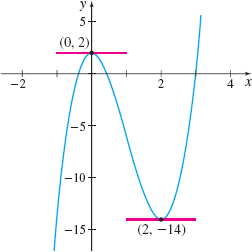EXAMPLE 6Solving Equations and Inequalities Involving Derivatives
- (a) Find the points on the graph of f(x)=4x3−12x2+2, where f has a horizontal tangent line.
- (b) Where is f′(x)>0? Where is f′(x)<0?
Solution (a) The slope of a horizontal tangent line is 0. Since the derivative of f equals the slope of the tangent line, we need to find the numbers x for which f′(x)=0. f′(x)=12x2−24x=12x(x−2)12x(x−2)=0f′(x)=0.x=0 or x=2Solve.

Figure 23 f(x)=4x3−12x2+2
At the points (0,f(0))=(0,2) and (2,f(2))=(2,−14), the graph of the function f(x)=4x3−12x2+2 has a horizontal tangent line.
(b) Since f′(x)=12x(x−2) and we want to solve the inequalities f′(x)>0 and f′(x)<0, we use the zeros of f′, 0 and 2, and form a table using the intervals (−∞,0), (0,2), and (2,∞).
| Interval | (−∞,0) | (0,2) | (2,∞) |
| Sign of f′(x)=12x(x−2) | Positive | Negative | Positive |
We conclude f′(x)>0 on (−∞,0)∪(2,∞) and f′(x)<0 on (0,2),